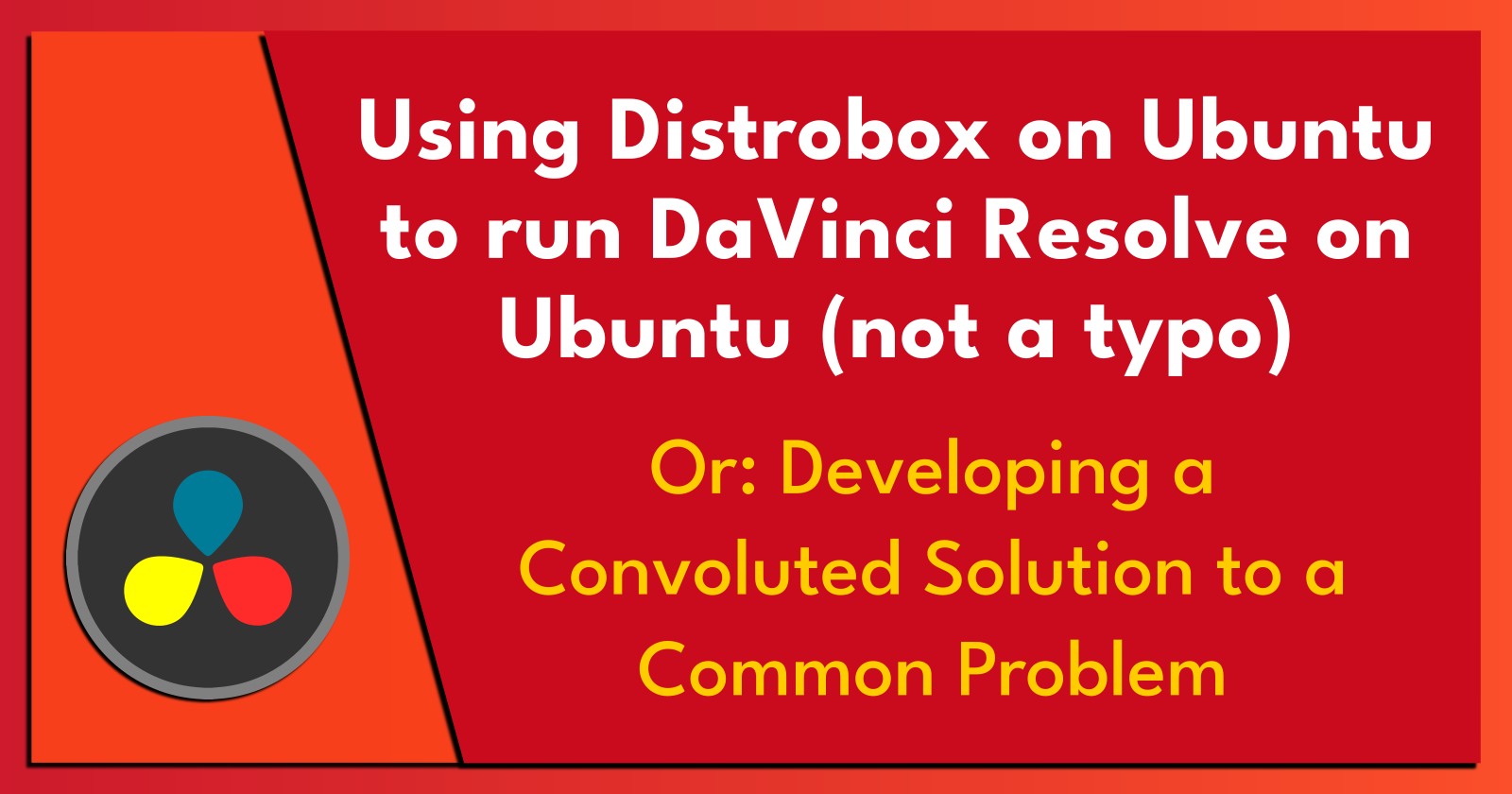Using Distrobox on Ubuntu to run DaVinci Resolve on Ubuntu (not a typo).
 Brian King
Brian King
TL;DR.
Running DaVinci Resolve on a Linux distribution (distro) other than CentOS, RHEL, or Rocky Linux is a problematic venture. The following post will present a way to easily test, and possibly host, DaVinci Resolve on other Linux distros.
Attributions:
https://www.youtube.com/watch?v=wmRiZQ9IZfc↗,
https://www.linuxfordevices.com/tutorials/linux/install-use-distrobox↗,
https://github.com/intel/compute-runtime/releases↗,
An Introduction.
Distrobox lets me run any Linux distro from my Ubuntu terminal.
The purpose of this post is to provide a process for hosting Distrobox on Ubuntu so Distrobox can run an Ubuntu container on which DaVinci Resolve will operate.
This tangled fix is a result of the limited, supported distros for DaVinci Resolve, i.e. the supported distros being CentOS, RHEL, and Rocky Linux.
The Big Picture.
Container technologies like Docker and LXD/LXC are very popular solutions that developers can use to "contain" their systems for portability or run isolated code that is easily disposable. In the case of DaVinci Resolve, I want to edit videos on the same system where the source files are created, i.e. Ubuntu. Distrobox is also a container technology that:
Runs ON, at least, 20 different distros (NOT including Windows or macOS), and
Unlike Docker and LXD/LXC, Distrobox's default configuration allows containers to:
Access the host file system, and
Access the host hardware resources.
I've chosen the Ubuntu distro to differentiate this post from its inspiration and test the viability of installing DaVinci Resolve on my Ubuntu-based workstation.
Prerequisites.
A Linux-based distro (I use Ubuntu),
Installing Ubuntu on Distrobox.
- I list the installed containers:
distrobox list
NOTE: This command will result in an empty list if Distrobox is newly installed.
- I create an Ubuntu distro and call it
ubuntu:
distrobox create --image docker.io/library/ubuntu:22.04 --name ubuntu
NOTE 1: A full list of distros is available online.
NOTE 2: Answer [y]es when the installer asks to "pull the image".
- I list the installed containers again:
distrobox list
NOTE: This time, a container called
ubuntuis listed.
- I enter the
ubuntucontainer:
distrobox enter ubuntu
NOTE 1: Installing the basic distro packages may take up to 5 minutes.
NOTE 2: The installation will ask to setup a minimum 8-character password.
NOTE 3: I The command prompt is used to identify the distro name, e.g.
yt@ubuntu:~/Desktop$is my prompt for the Ubuntu distro container.
Installing the DaVinci Resolve Dependencies.
- From within the
ubuntucontainer, I update the distro:
sudo apt clean && sudo apt update && sudo apt dist-upgrade -y && sudo apt --fix-broken install && sudo apt autoremove -y
WARNING === WARNING === WARNING
The DaVinci Resolve installer does NOT work with fuse3. The fuse command below will replace fuse3. After installing DaVinci Resolve, I needed to re-install my desktop (which includes fuse3) to get my desktop icons and right-click functionality to work again:
sudo apt install --reinstall ubuntu-desktopYOU HAVE BEEN WARNED!!!
- I install the Fuse library:
sudo apt install -y fuse
- I install the rest of the required dependencies:
sudo apt install -y libapr1 libaprutil1 libglu1-mesa libnuma1 libxcb-composite0 libxcb-cursor0 libxcb-damage0 libxcb-icccm4 libxcb-image0 libxcb-keysyms1 libxcb-render-util0 libxcb-util1 libxcb-xinerama0 libxcb-xinput0 libxcb-xkb1 libxkbcommon-x11-0 ocl-icd-libopencl1 libasound2 libxcb-shape0 libxtst6
- I install the NVIDIA device driver:
sudo apt install -y nvidia-driver-535
NOTE 1: This device driver is proprietary and works with my GTX3060 graphics card. I must select the right driver for the GPU I have installed.
NOTE 2: Installing this device driver may take up to 5 minutes.
Installing DaVinci Resolve.
- I download DaVinci Resolve:
https://www.blackmagicdesign.com/event/davinciresolvedownload
- From a terminal, I change to the Downloads directory:
cd ~/Downloads/
- I unzip the download file, for example:
unzip ./DaVinci_Resolve_18.6.3_Linux.zip
NOTE: At the time of writing, 18.6.3 was the latest version.
- I change the mode of the
.runfile to an executable, for example:
chmod +x ./DaVinci_Resolve_18.6.3_Linux.run
- I install DaVinci Resolve:
sudo ./DaVinci_Resolve_18.6.3_Linux.run -i
NOTE: Missing dependencies may be listed during the installation process. These dependencies will need to be installed before repeating the DaVinci Resolve installation.
- I run DaVinci Resolve:
/opt/resolve/bin/resolve
DaVinci Resolve running on my Intel NUC 10.
Running DaVinci Resolve on my Intel NUC 10 presents the dreaded "Unsupported GPU Processing Mode" modal box. My solution to this error is as follows.
- I visit the GitHub repo for Intel and follow their instructions:
https://github.com/intel/compute-runtime/releases
- I add my account to the video group:
sudo gpasswd -a $USER video
- I run DaVinci Resolve:
/opt/resolve/bin/resolve
The Results.
Openbox has advantages over Docker and LXD/LXC including:
Direct access to the host file system,
Direct access to the host hardware resources,
It is easy to setup and use, and
It is lightweight.
When it comes to installing (and running) DaVinci Resolve, each distro will require unique deployment tweaks depending on the following system components:
Intel vs. AMD CPUs,
NVIDIA vs. AMD GPUs, and
Choice of Linux distro within each container.
Although my NUC doesn't use an NVIDIA chipset, I still had the option of using OpenCL. (The Internet exists to solve ALL my problems. Except...)
One major issue is that MP4 videos are not supported in the free version of DaVinci Resolve for Linux. This issue does NOT exist when using the paid version called DaVinci Resolve Studio (at least, that is my personal experience when running Studio on my Ubuntu system) or DaVinci Resolve for Windows. The ffmpeg utility can re-encode the audio and/or video from MP4 and there are many online resources that show this process.
Other possible solutions (which I haven't tried yet) is to run Rocky Linux or CentOS on Distrobox.
In Conclusion.
Running DaVinci Resolve on Ubuntu using Distrobox on Ubuntu is a viable solution for testing this powerful video editor on unsupported distributions. By defining and following these installation and configuration steps, I can set up DaVinci Resolve in a containerized environment which allows me to evaluate if installation on my preferred Linux distribution is possible.
BTW, video editing is my least favourite media production activity. I suck at it. (Alright, I suck am not very good at a lot of other things, too.)
Until next time: Be safe, be kind, be awesome.
Subscribe to my newsletter
Read articles from Brian King directly inside your inbox. Subscribe to the newsletter, and don't miss out.
Written by

Brian King
Brian King
Thank you for reading this post. My name is Brian and I'm a developer from New Zealand. I've been interested in computers since the early 1990s. My first language was QBASIC. (Things have changed since the days of MS-DOS.) I am the managing director of a one-man startup called Digital Core (NZ) Limited. I have accepted the "12 Startups in 12 Months" challenge so that DigitalCore will have income-generating products by April 2024. This blog will follow the "12 Startups" project during its design, development, and deployment, cover the Agile principles and the DevOps philosophy that is used by the "12 Startups" project, and delve into the world of AI, machine learning, deep learning, prompt engineering, and large language models. I hope you enjoyed this post and, if you did, I encourage you to explore some others I've written. And remember: The best technologies bring people together.